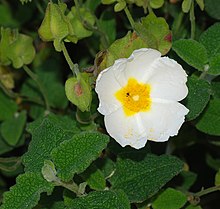| Cistus salviifolius | |
|---|---|

| |
| Scientific classification | |
| Kingdom: | Plantae |
| Clade: | Tracheophytes |
| Clade: | Angiosperms |
| Clade: | Eudicots |
| Clade: | Rosids |
| Order: | Malvales |
| Family: | Cistaceae |
| Genus: | Cistus |
| Species: | C. salviifolius |
| Binomial name | |
| Cistus salviifolius L. | |
Cistus salviifolius, common names sage-leaved rock-rose, salvia cistus or Gallipoli rose, is a shrub of the family Cistaceae.
Etymology
The genus name Cistus derives from the Ancient Greek words κίσθος (kisthos) meaning basket, while the species name salviifolius refers the wrinkled leaves similar to those of the sage.
Description
Cistus salviifolius has spreading stems covered by clumpy hairs. This bushy shrub reaches on average 30–60 centimetres (12–24 in) in height, with a maximum of 100 centimetres (39 in). The oval-shaped green leaves are 1 to 4 centimeters long, opposite, reticulate, tomentose on both sides, with a short petiole (2–4 mm).
The inflorescence holds one or more round flowers, long-stalked, arranged at the leaf axils. The five white petals have a yellow spot at the base, forming a corolla 4–6 cm in diameter. The stamens are also yellow and the anthers shed abundant yellow pollen. This plant is pollinated by insects (entomophily), especially by bees. The flowering period extends from April through May. The fruit is a pentagonal capsule, 5–7 mm long.
Phylogeny
Cistus salviifolius belongs to the white and whitish pink flowered clade of Cistus species.
| Species-level cladogram of Cistus species. | ||||||||||||||||||||||||||||||||||||||||||||||||||||||||||||||||||||||||||||||||||||||||||||||||||||||||||||||
| ||||||||||||||||||||||||||||||||||||||||||||||||||||||||||||||||||||||||||||||||||||||||||||||||||||||||||||||
| Species-level cladogram of Cistus species, based on plastid and nuclear DNA sequences. |
Gallery
-
Plants of Cistus salviifolius
-
Close-up on a flower of Cistus salviifolius
-
 Fruits of Cistus salviifolius
Fruits of Cistus salviifolius
-
 Close-up on a fruit of Cistus salviifolius
Close-up on a fruit of Cistus salviifolius
-
Leaves of Cistus salviifolius
Cultivation
Cistus salviifolius cultivated in the nursery industry, and grown in gardens and public landscapes, often for its drought-tolerant and pollinator habitat attributes.
Distribution
This showy wildflower is native to the Mediterranean region, in southern Europe and parts of Western Asia and North Africa.
Habitat
This plant prefers dry hills, scrubland and open woodlands, at an altitude of 0–1,200 metres (0–3,937 ft) above sea level. It regrows very quickly following a fire.
Synonyms
|
|
Other synonyms reported by The Plant List include:
- Cistus apricus Timb.-Lagr.
- Cistus arrigens Timb.-Lagr.
- Cistus elegans Timb.-Lagr.
- Cistus fruticans Timb.-Lagr.
- Cistus humilis Timb.-Lagr.
- Cistus microphyllus Timb.-Lagr.
- Cistus platyphyllus Timb.-Lagr.
- Cistus rhodanensis Timb.-Lagr.
- Cistus sideritis C.Presl
- Cistus velutinus Timb.-Lagr.
Chemistry
Cistus salviifolius contains flavan-3ols, oligomeric proanthocyanidins and prodelphinidins such as epigallocatechin-3-O-(4-hydroxybenzoate), epigallocatechin-(4β→8)-epigallocatechin, epigallocatechin -3-O-gallate-(4β→8)-epigallocatechin, epigallocatechin-(4β→6)-epigallocatechin-3-O-gallate, 1-O-β-d -(6′-O-galloyl)-glucopyranosyl-3-methoxy-5-hydroxybenzene, epigallocatechin-(4β→8)-epigallocatechin-3-O-gallate, 1-O-β-d- glucopyranosyl-3-methoxy-5-hydroxybenzene and rhododendrin (betuloside). It also contains ellagitannins of the punicalagin type.
References
- BSBI List 2007 (xls). Botanical Society of Britain and Ireland. Archived from the original (xls) on 26 June 2015. Retrieved 17 October 2014.
- NRCS. "Cistus salviifolius". PLANTS Database. United States Department of Agriculture (USDA). Retrieved 17 January 2016.
- "Acta Plantarum". Archived from the original on 2013-04-25. Retrieved 2011-09-06.
- ^ Pignatti S. - Flora d'Italia – Edagricole – 1982. Vol. II, pag. 122.
- Guzmán, B. & Vargas, P. (2005). "Systematics, character evolution, and biogeography of Cistus L. (Cistaceae) based on ITS, trnL-trnF, and matK sequences". Molecular Phylogenetics and Evolution. 37 (3): 644–660. Bibcode:2005MolPE..37..644G. doi:10.1016/j.ympev.2005.04.026. PMID 16055353.
- Guzmán, B. & Vargas, P. (2009). "Historical biogeography and character evolution of Cistaceae (Malvales) based on analysis of plastid rbcL and trnL-trnF sequences". Organisms Diversity & Evolution. 9 (2): 83–99. Bibcode:2009ODivE...9...83G. doi:10.1016/j.ode.2009.01.001.
- Guzman, B.; Lledo, M.D. & Vargas, P. (2009). "Adaptive Radiation in Mediterranean Cistus (Cistaceae)". PLOS ONE. 4 (7): e6362. Bibcode:2009PLoSO...4.6362G. doi:10.1371/journal.pone.0006362. PMC 2719431. PMID 19668338.
- Civeyrel, Laure; Leclercq, Julie; Demoly, Jean-Pierre; Agnan, Yannick; Quèbre, Nicolas; Pélissier, Céline & Otto, Thierry (2011). "Molecular systematics, character evolution, and pollen morphology of Cistus and Halimium (Cistaceae)". Plant Systematics and Evolution. 295 (1–4): 23–54. Bibcode:2011PSyEv.295...23C. doi:10.1007/s00606-011-0458-7. S2CID 21995828.
- Synonyms in Anthos
- Timb.-Lagr. Rev. Bot. Bull. Mens. 10: 70 1892
- Antioxidant oligomeric proanthocyanidins from Cistus salvifolius. Fadi Qa’dan, Frank Petereit, Kenza Mansoor and Adolf Nahrstedt, Natural Product Research, Volume 20, Issue 13, 2006, pages 1216-1224, doi:10.1080/14786410600899225
- Flavan-3-ols, prodelphinidins and further polyphenols from Cistus salvifolius. Andreas Danne, Frank Petereit and Adolf Nahrstedt, Phytochemistry, 37, (2), 1994, Pages 533–538, doi:10.1016/0031-9422(94)85094-1
- Simultaneous LC-DAD and LC-MS Determination of Ellagitannins, Flavonoid Glycosides, and Acyl-Glycosyl Flavonoids in Cistus salvifolius L. Leaves. E. Saracini, M. Tattini, M. L. Traversi, F. F. Vincieri and P. Pinelli, Chromatographia, Volume 62, Numbers 5-6, pages 245-249, doi:10.1365/s10337-005-0623-7
External links
- Cistus salviifolius in the CalPhotos photo database, University of California, Berkeley
- "Cistus salviifolius". Calflora. Berkeley, California: The Calflora Database.
- "Cistus salviifolius". Plants for a Future.
- Jepson Manual Treatment - Cistus salviifolius
| Taxon identifiers | |
|---|---|
| Cistus salviifolius |
|